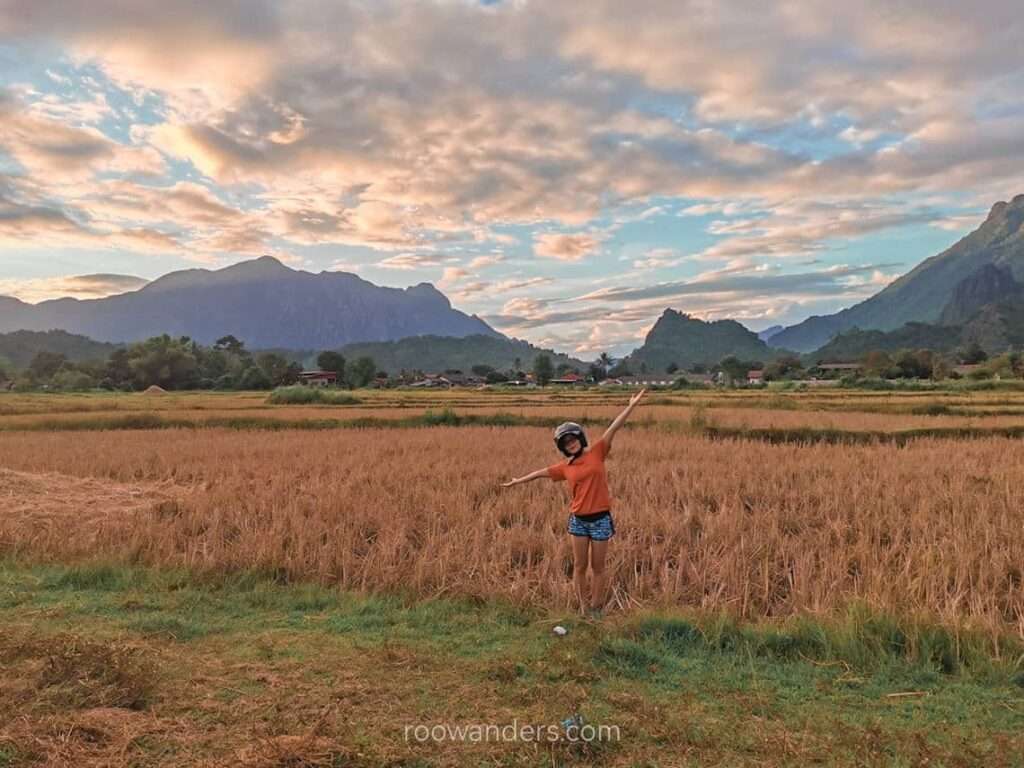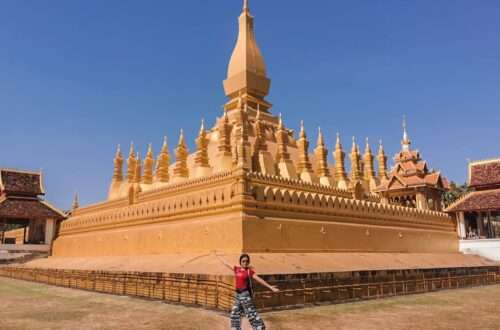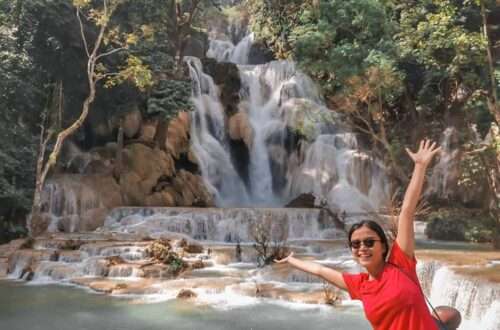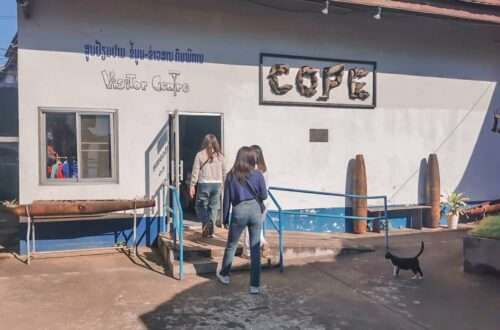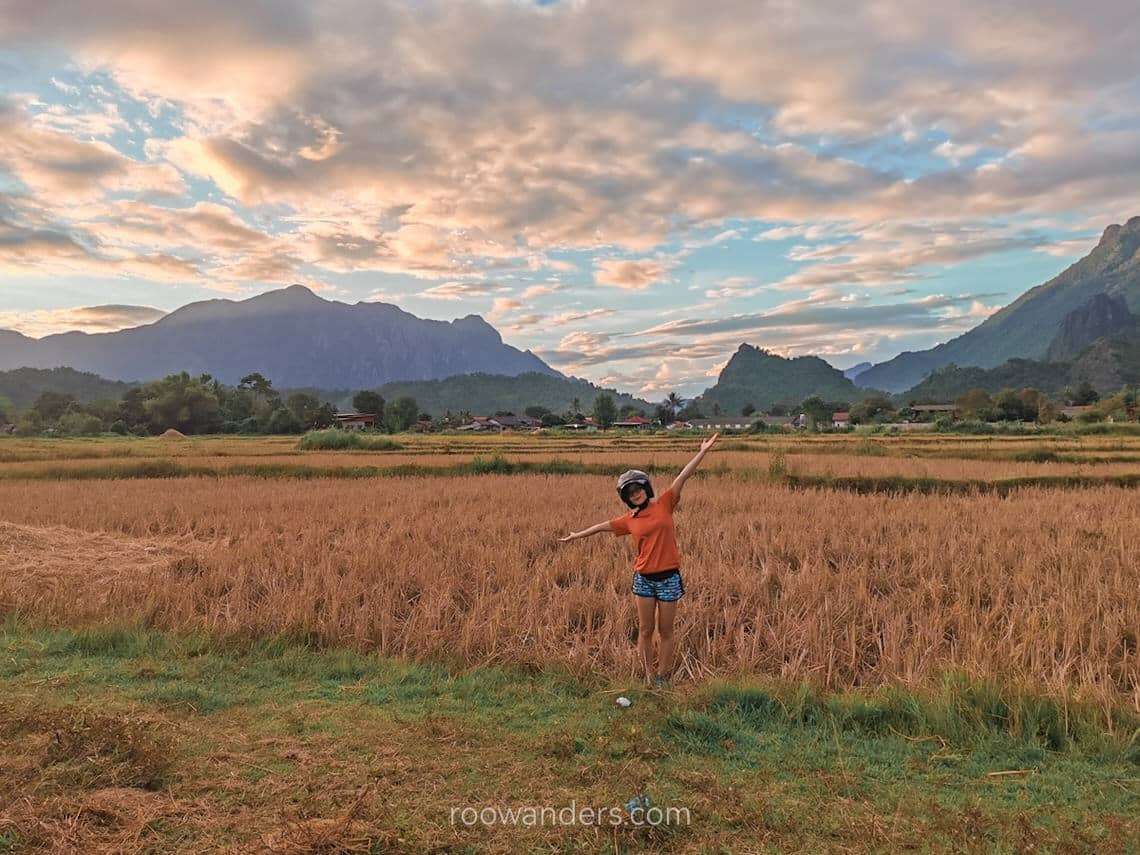
Guide to Your Vang Vieng Adventures
Vang Vieng, the small little town between Vientiane and Luang Prabang, is home to some serious adventures in Laos. From hot air balloons over towering karsts to visiting caves on tubes bobbing gently down the river, there is plenty to do in Vang Vieng.
Once a crazy party town, Vang Vieng still is predominantly dominated by backpackers. However, boutique hotels and tours catering for a more mature group have begun sprouting in this charming laid-back destination.
Here’s a post on the things to do in Vang Vieng, including the attractions and activities, the delicious food I enjoyed, and the accommodations I’d recommend. Let’s go!
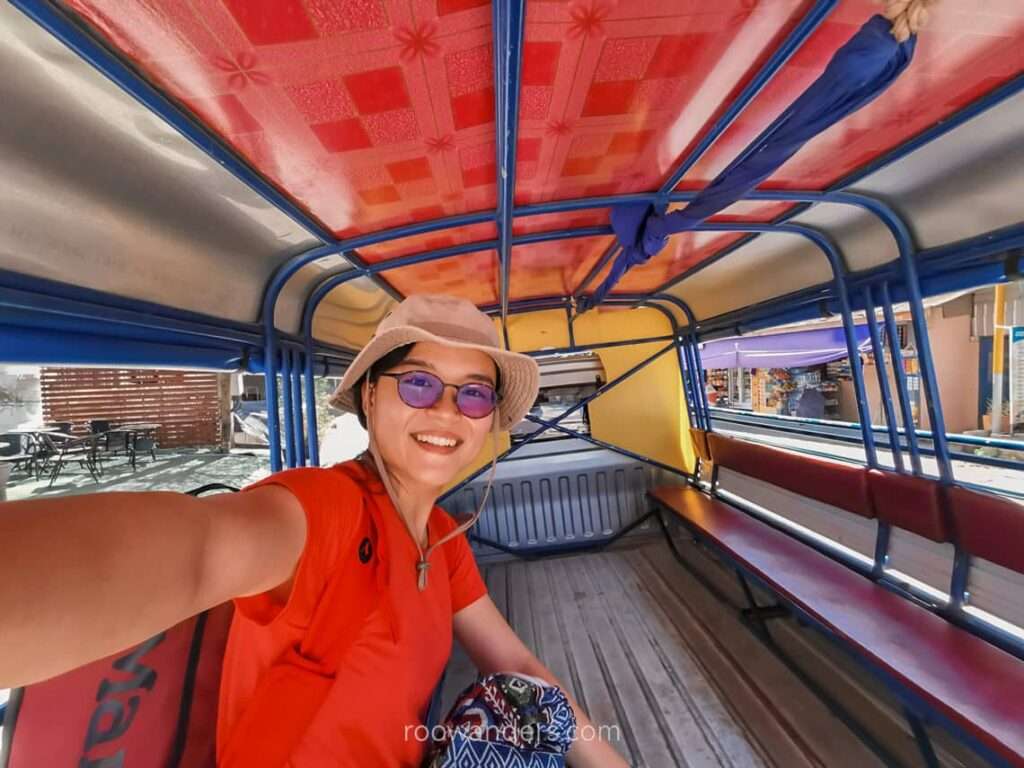
I visited Vang Vieng in Nov 2023. This post contains affiliate links that cost nothing to you but support my blog! It may also be updated periodically. Cheers!
Best Time to visit Vang Vieng
The dry and cool months of November to January are generally the best period to travel in Laos. Daytime temperatures are agreeable, though early mornings and late nights can be a little chilly.
Expect heavy rainfall from June to October. Travelling during the peak rainy season can be hazardous or even impossible with road closures and floods. Even if you were to get to your destination, certain attractions may be closed – for instance, the low cave Tham Nam. In exchange for the wetness, you’d get roaring waterfalls and full rivers.
The period between March and May coincided with the country’s slash-and-burn season. You’d have acrid smog everywhere that paints the sky a dusty orange, and fill your clothes and hair with particles and a lingering burnt smell. A friend of mine visited in April 2023 and had to wear a mask throughout her trip. Her Nam Xay views were painted an orangey hue.
Getting to Vang Vieng
Vang Vieng has no airport.
There are only two ways to reach Vang Vieng via public transport. You could get your tickets from third-party booking sites like 12Go or other travel agency sites, from your accommodation, or directly from the LCR app if taking the high-speed train.
Bus
Taking the bus from Vientiane to Vang Vieng is the most common and convenient way to travel. The journey takes about 2 – 3 hours, depending on traffic. Buses to Vang Vieng leave Vientiane from the Northern Bus Station, about 8 km from the city centre. Some companies offer pick up from your accommodation. But you could hail a taxi or loca too.
Buses to Vang Vieng end at a bus station about 2 km north of the town centre. But some may stop somewhere closer to town, as my buddy had experienced. Otherwise, hail for a tuk-tuk – around 30k kip per person.
Travelling from Luang Prabang to Vang Vieng is tedious. The journey takes 6 hours. Luang Prabang Bus Station is about 2 km southwest of the city centre.
Train
I took the Laos-China Railway from Vientiane to Vang Vieng. The journey from Vientiane to Vang Vieng took almost 30 minutes as the railway station was 15 km northeast of the city centre. But the journey from Vientiane to Vang Vieng was fast – slightly less than an hour!
As with all the high-speed railway stations in Laos, the station in Vang Vieng is out of town. We took a tuk-tuk for 30k kip each to cover the remaining 5 km to the town’s centre.
If you’re travelling from Luang Prabang to Vientiane, opt for the train. That will save 5 hours of travelling time since the journey takes just one hour.
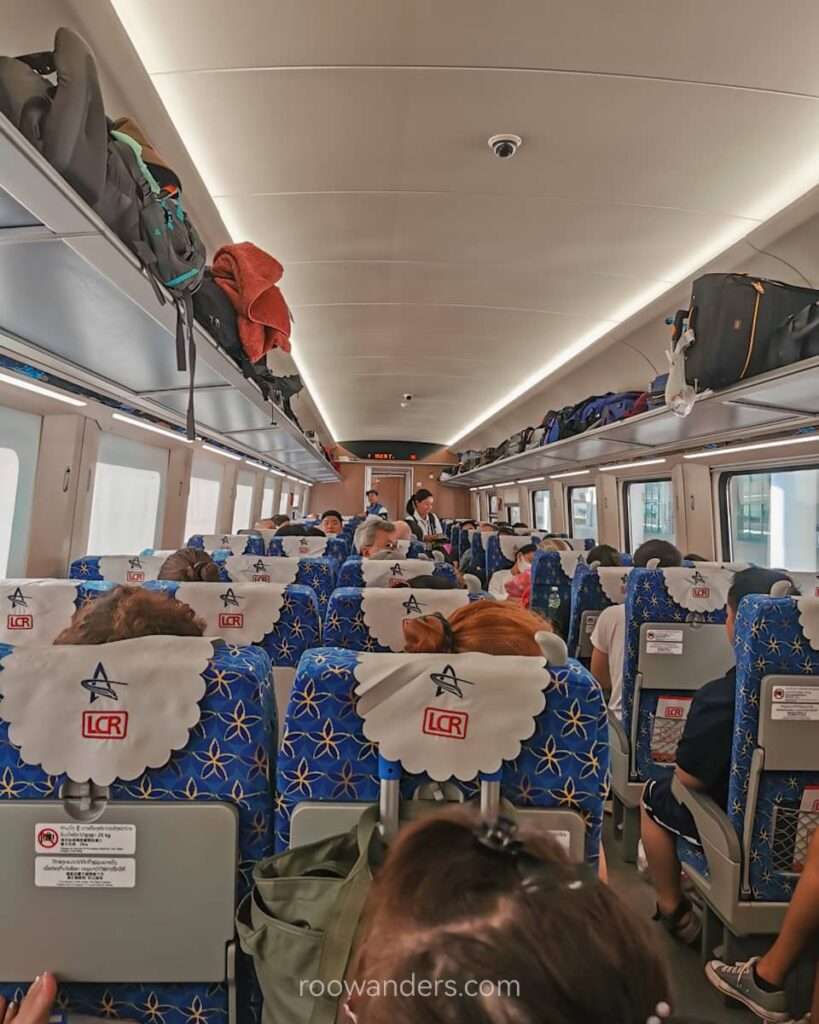
Luang Prabang railway station is 11 km southeast of the city centre. A tuk-tuk from the railway station to Luang Prabang city centre costs 40k kip, which should cost likewise in reverse. It was a rough ride over potholed roads that took almost 30 minutes as well.
Travelling within Vang Vieng
Walking
You can get to places within Vang Vieng town with ease by walking. The town is small. But most attractions are beyond a reasonable walking distance, and that’s when a bicycle, motorbike, tuk tuk or organised tours come in.
Cycling
While I did not cycle there, I saw shops renting bicycles and electric bikes. You may rent them from your accommodations as well. Make sure you get mountain bikes for the rough roads. Watch out for the potholes!
Motorbike
Same with cycling but less strenuous. Rent your motorbike from the many shops around Vang Vieng, but make sure you are licensed! Shops would keep your passport in exchange for the motorbike. Motorbike rental starts from 100k kip to 150k kip per day, depending on the make and model.
Word of caution: there are cases of stolen motorbikes after dark. It would be wise to rent by day or arrange with your accommodation to have them locked within the compound.
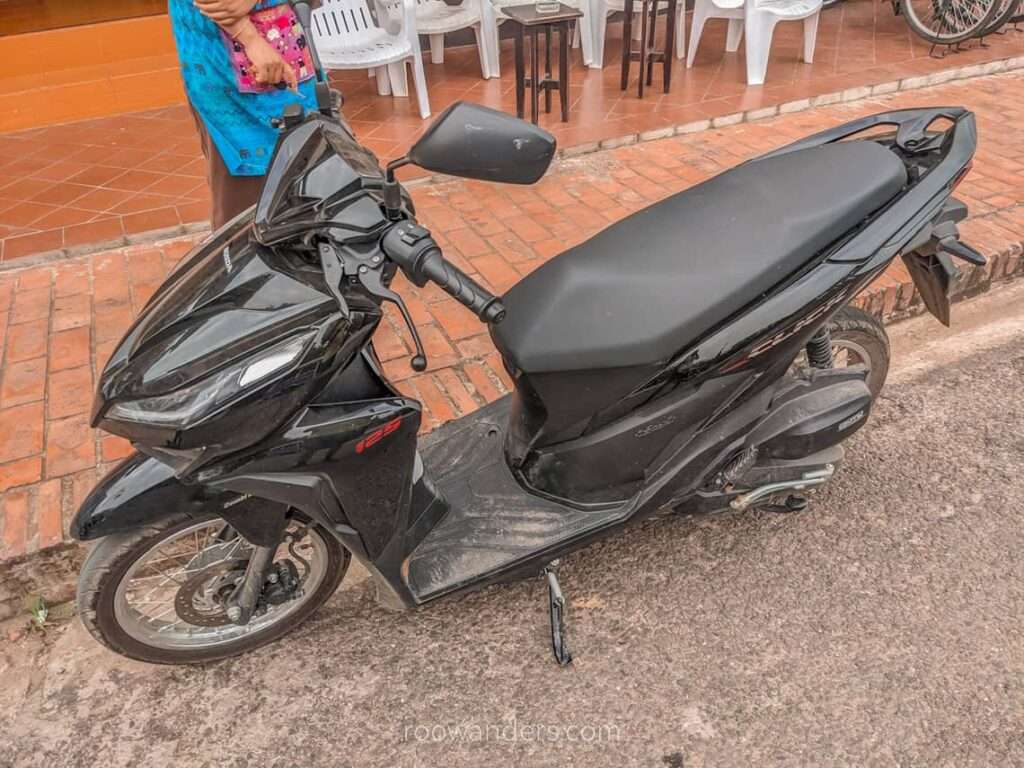
Attractions & Activities around Vang Vieng
Vang Vieng is home to plenty of limestones. With that, you get imposing mountain karsts and mysterious caves. There are a myriad of activities to do, from the sky to the mountains to the rivers.
Karsts Hikes
There are several mountain karsts to hike, and you’re only limited by your guts – some are not well maintained – and physical strength.
Nam Xay Viewpoint
Nam Xay Viewpoint is the most popular spot to capture a panorama of Vang Vieng’s breathtaking views. Nam Xay is about 8 km west of Vang Vieng or 20 mins on the motorbike. It is another 30 minutes to reach the summit for the prized motorbike shoot.
There’ll be an elevation gain of 129 m.
Tickets cost 20k kip, and the park is open from 6 AM to 5 PM. I’ll be writing a separate ✨detailed✨ post about my hike and pointers to note. Know that this trek requires proper hiking shoes and a bit of bouldering, similar to – but definitely easier than – my climb at the Mulu Pinnacles.
I’ve written about my experience up Nam Xay here!
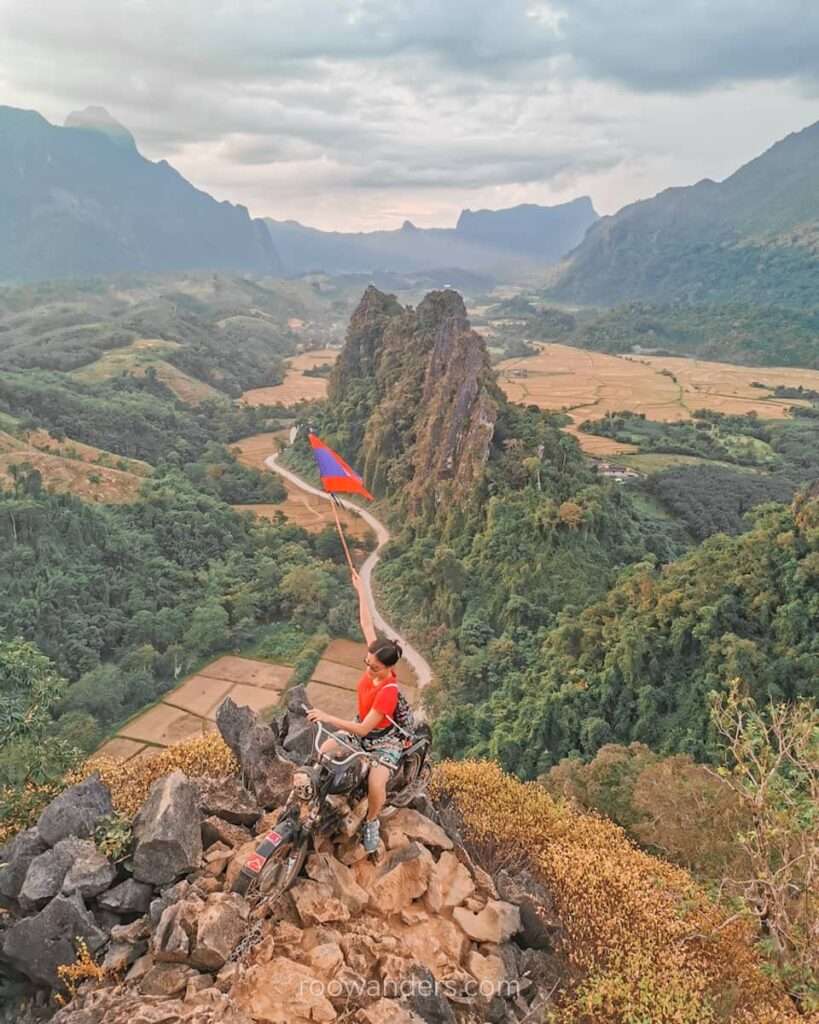
Pha Ngern Viewpoint
Another popular viewpoint, which some thought of as better than that of Nam Xay. Buffer about 2 hours for the return hike. It has an elevation gain of 351 m.
Tickets should cost 20k kip too.
Silver Cliff Viewpoint
The toughest and longest viewpoint in Vang Vieng with an elevation gain of 481 m, and about 2h 30 mins to complete the returned track. There are Upper and Lower viewpoints.
Tickets cost 20k kip.
Caves Exploration
Vang Vieng has caves of all sorts and sizes, and Buddhas in each and every one of them. Keep your eyes peeled, as there might just be one hiding in the crevices.
I appreciate caves, having been to several like Waitomo in New Zealand, big caves in Mulu National Park of Malaysia, and the biggest cave in the world – Hang Son Doong – in Vietnam. It’s a whole new world within!
Golden Crab Cave (Tham Phu Kham)
Phu Kham Cave and the Blue Lagoon are conveniently situated before Nam Xay, making this cave + lagoon and Nam Xay a good half-day trip.
It costs 20k kip to visit both the cave and the lagoon. Climb a few jagged limestone steps to reach the cave entrance. Descend the same limestone rocks, which might be slippery from the water dripping from the cave ceiling, to reach the reclining Buddha. If you timed your visit right, you may just witness the rare sunbeam shining horizontally into the cave and onto the Buddha.
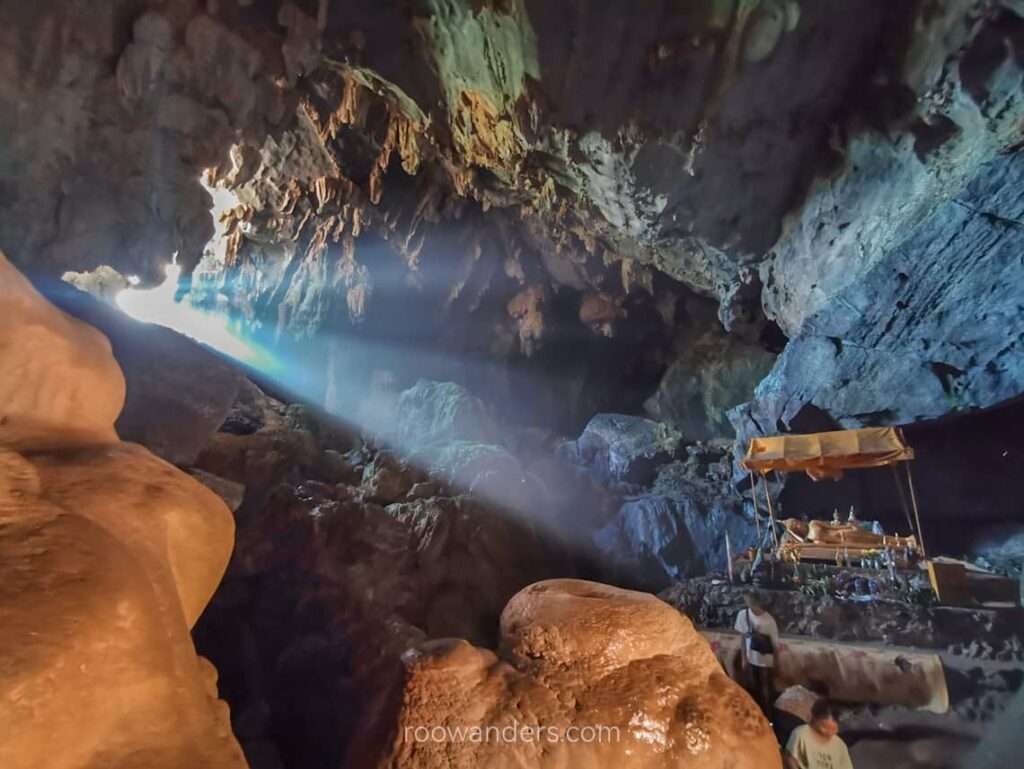
Jang Cave (Tham Chang)
Tham Chang Cave, located 2 km south of Vang Vieng, is spread over two levels with proper-lit walkways within. Lots of massive stalagmites, stalactites and columns.
To get to the cave, you’d pass through a gate that charges 5k kip for supposedly crossing a bridge. But we saw no bridge, only a raft that travels between the two coasts. From there, it was a short walk across wooden bridges over sparkling blue lagoons. Next came the 150 concrete steps to the top after paying an entrance fee of 15k kip.
Expect another wonderful visage of Vang Vieng from another angle at the top!
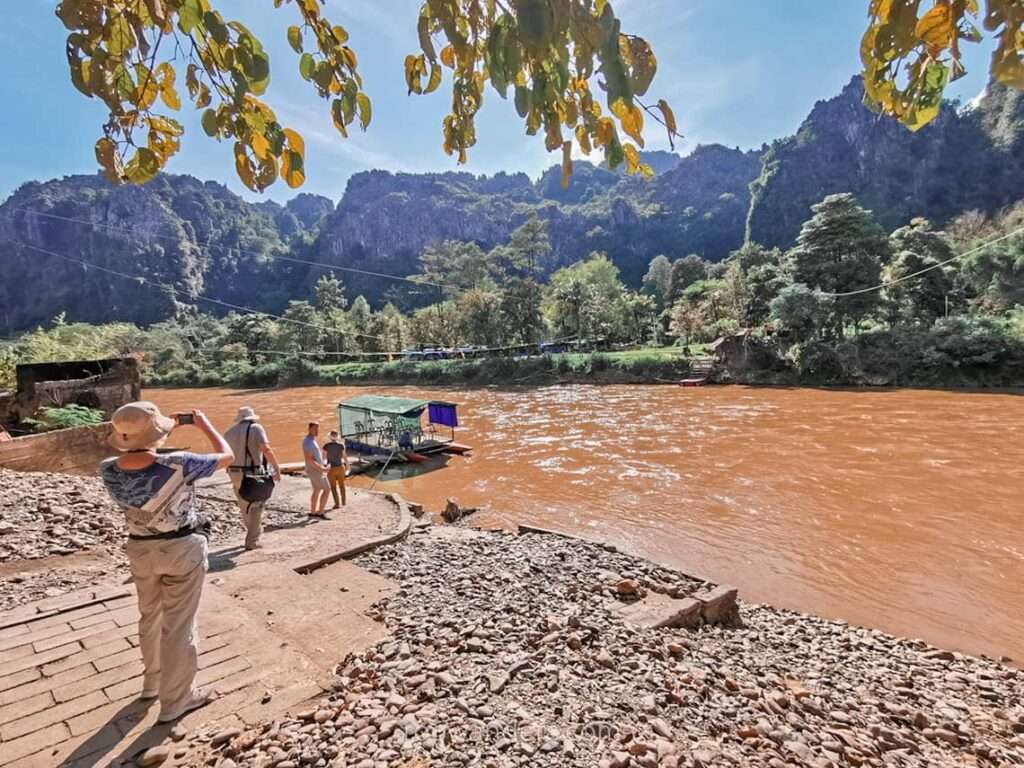
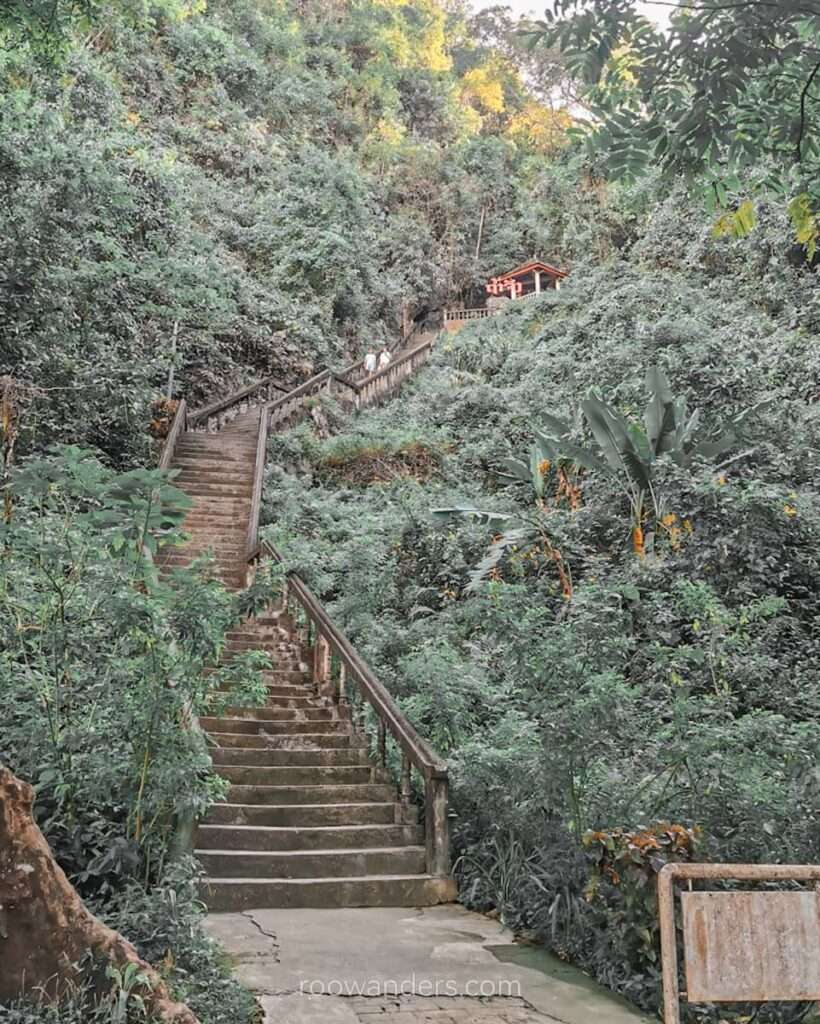
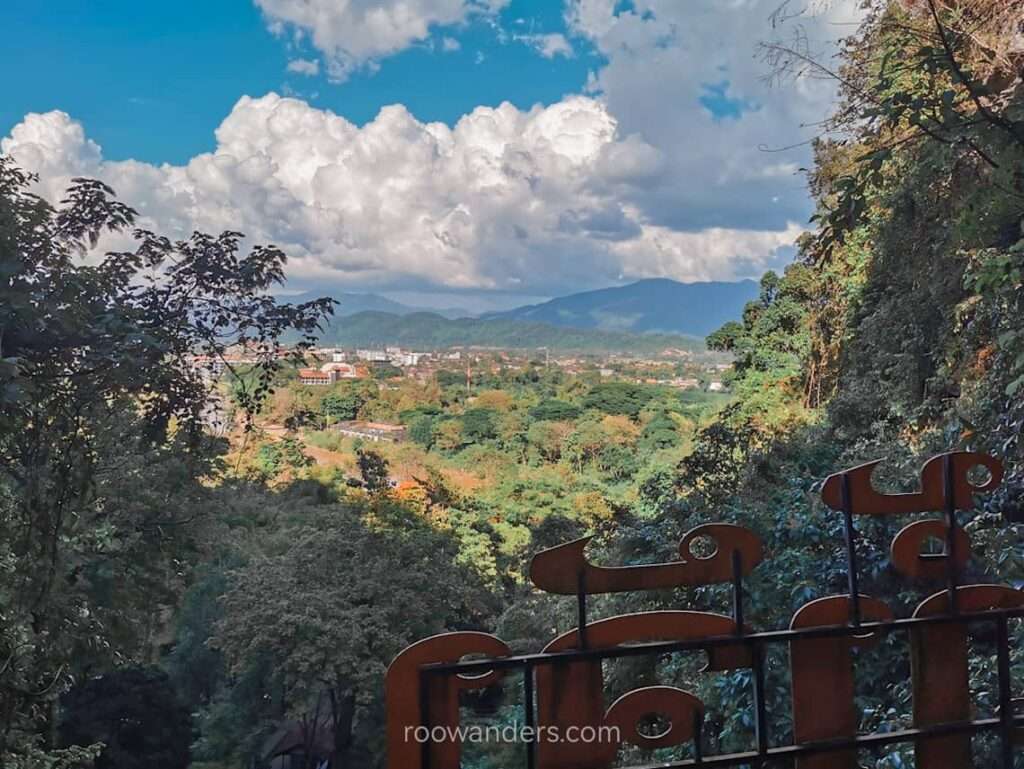
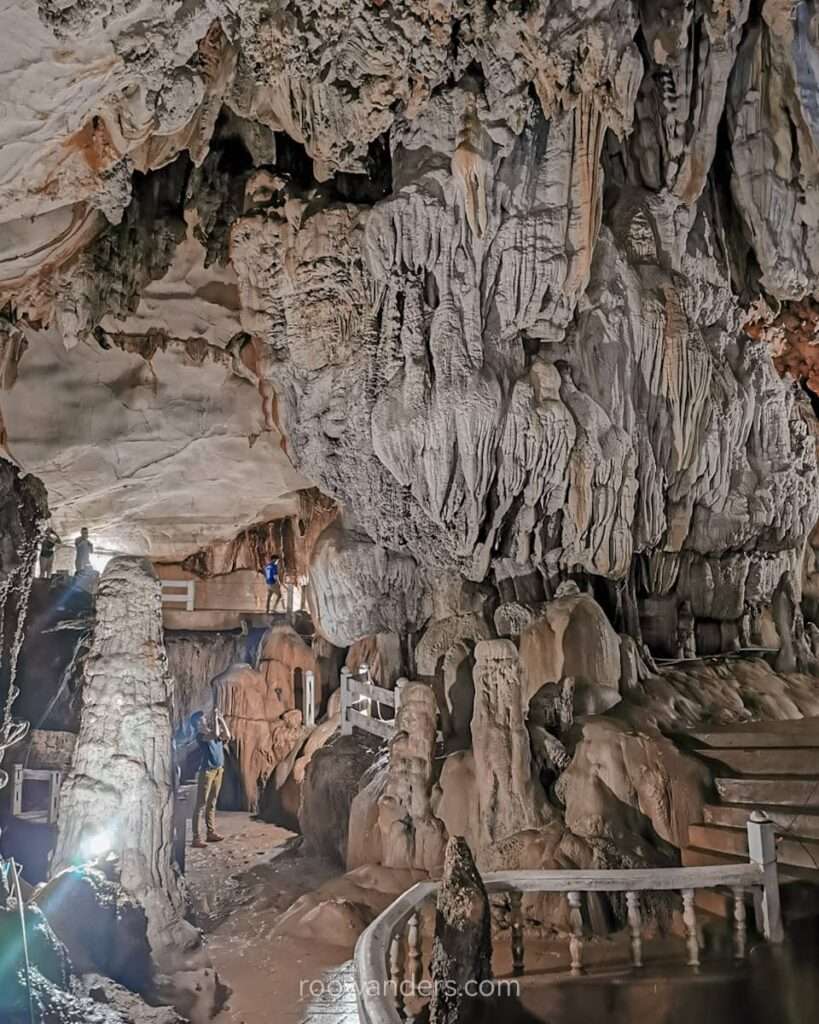
Elephant Cave (Tham Xang)
Travel about 14 km north of Vang Vieng to a series of four caves – Tham Xang, Tham Nam, Tham Loup, and Tham Hoi.
Tham Xang, or the Elephant Cave, as its name suggests, contains a stalactite that looks like the four-legged majestic beast. Apart from the cave formations, there are also bones of elephants within. The cave contains a collection of Buddhas and ‘an imprint’ of the Buddha’s footprint.
The Elephant Cave is the first cave you’d encounter in this series of caves. The ticket price should be 15 – 20k kip. We decided to skip this since we weren’t that interested in this smallish cave, based on Google reviews.
Water Cave (Tham Nam)
Head further on potholed muddy routes, and park your bikes within the compound. Tham Nam consists of pulling yourself into the cave via a tube. There are lockers to keep your valuables, and it’ll be best if you come prepared in your swimwear. Tickets cost 20k kip, and we were given a headlamp each.
In retrospect, the experience of pulling ourselves into the caves via tubes is novel. It took some effort as we were travelling against the current. Within the cave, however, there isn’t anything spectacular. No fancy stalactites. What you have is a low-hanging cave wall with scalloped features like the one I’ve seen in Mulu National Park. I can imagine this cave being fully submerged during the wet season.
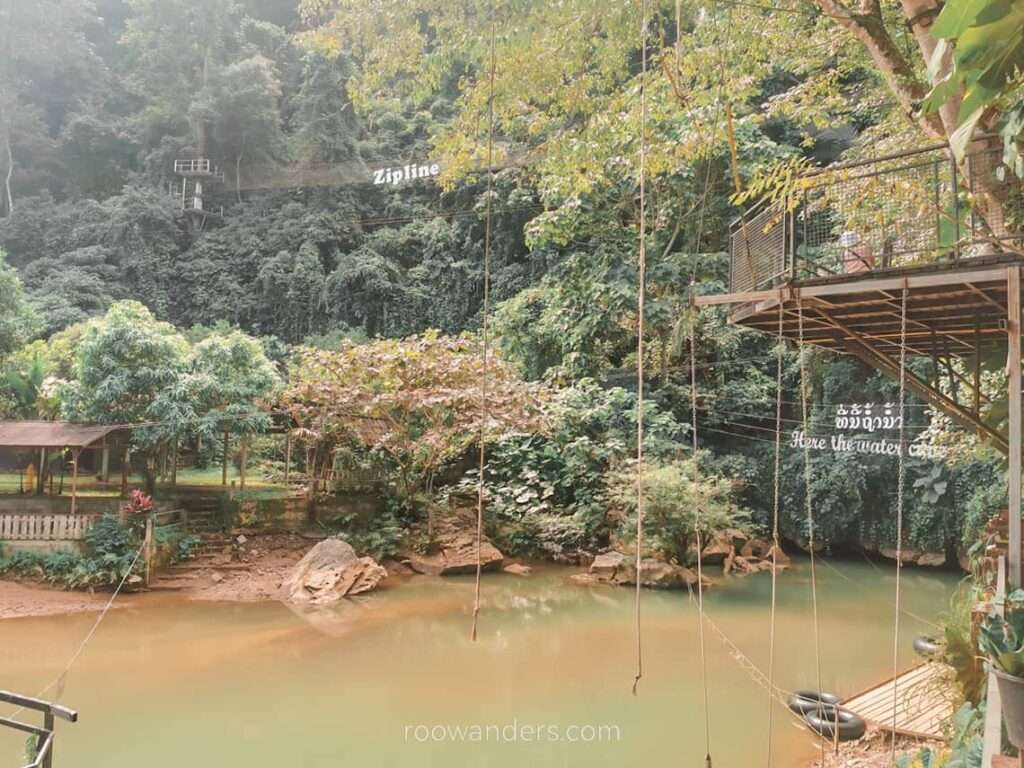
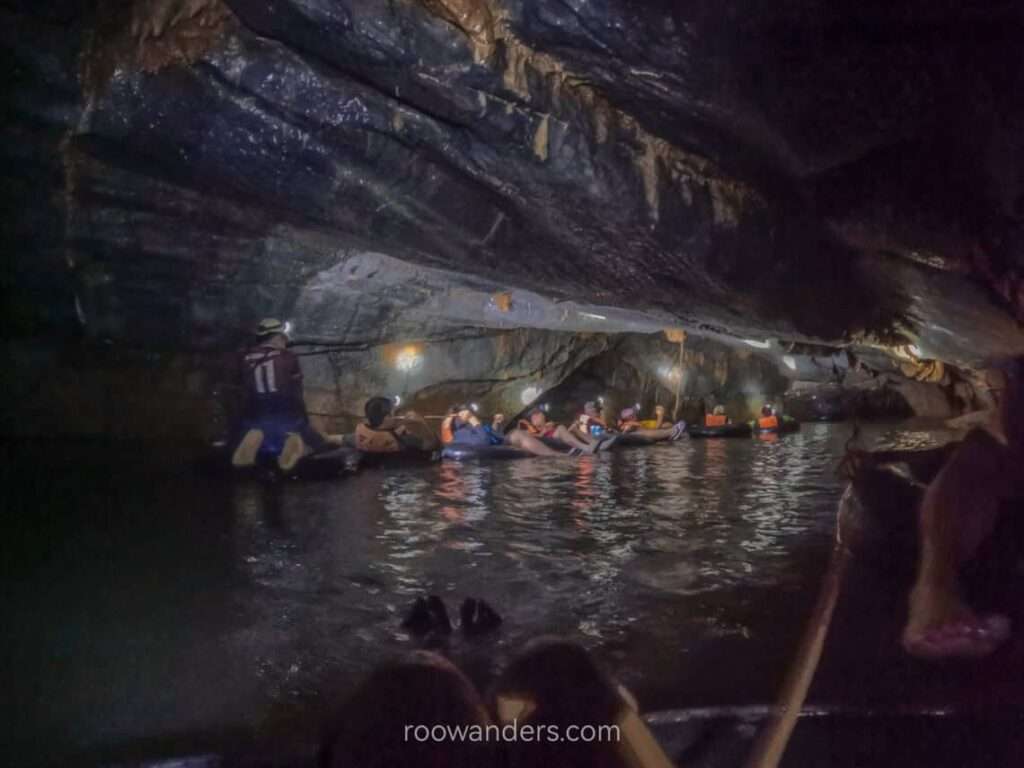
At the end of the ropes is a shallow place full of gravel and pebbles. The cave extends further, but you’d have to walk in to explore.
Most tours combine the visit with a zipline. We saw a group of Koreans zip-lining around the park on the morning of our visit.
If you’re only interested in visiting Tham Nam, kayaking on Nam Song River, and zip lining, consider going for this full-day lunch-inclusive adventure tour for a hassle-free experience.
Snail Cave (Tham Hoi)
Tham Loup and Tham Hoi are next to each other, and some 10 – 15 mins walk or 2 mins motorbike from Tham Nam on muddy roads.
We paid 15k kip for each cave and were given headlamps.
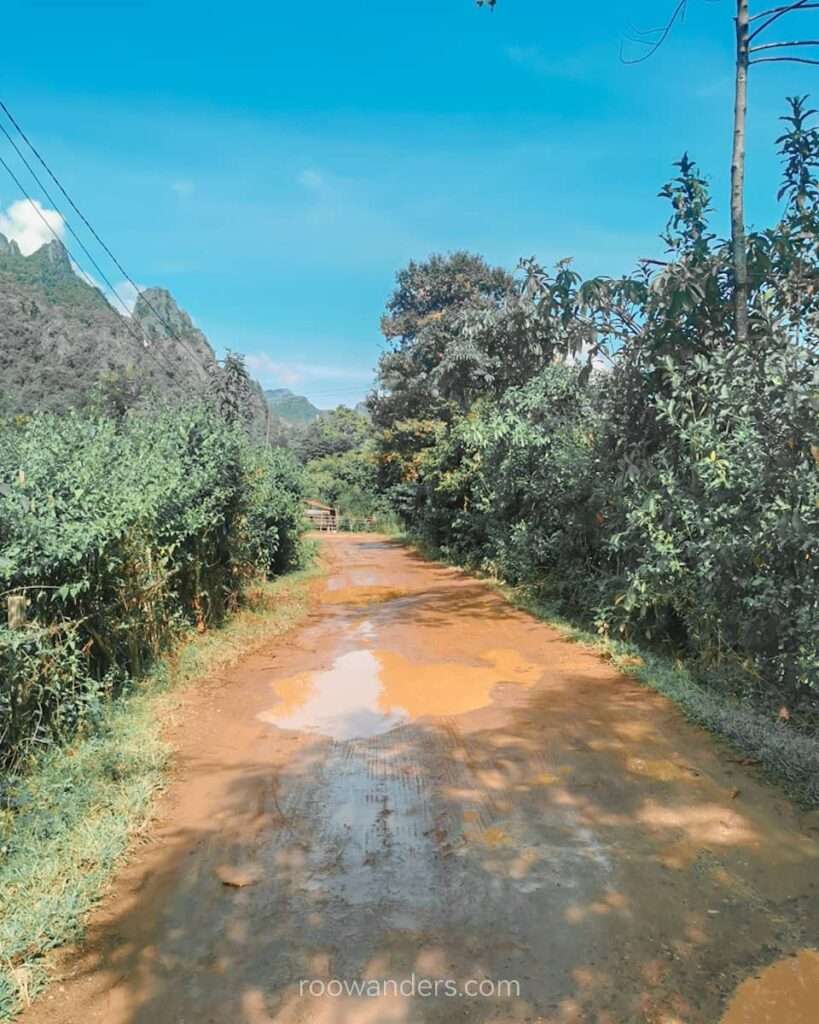
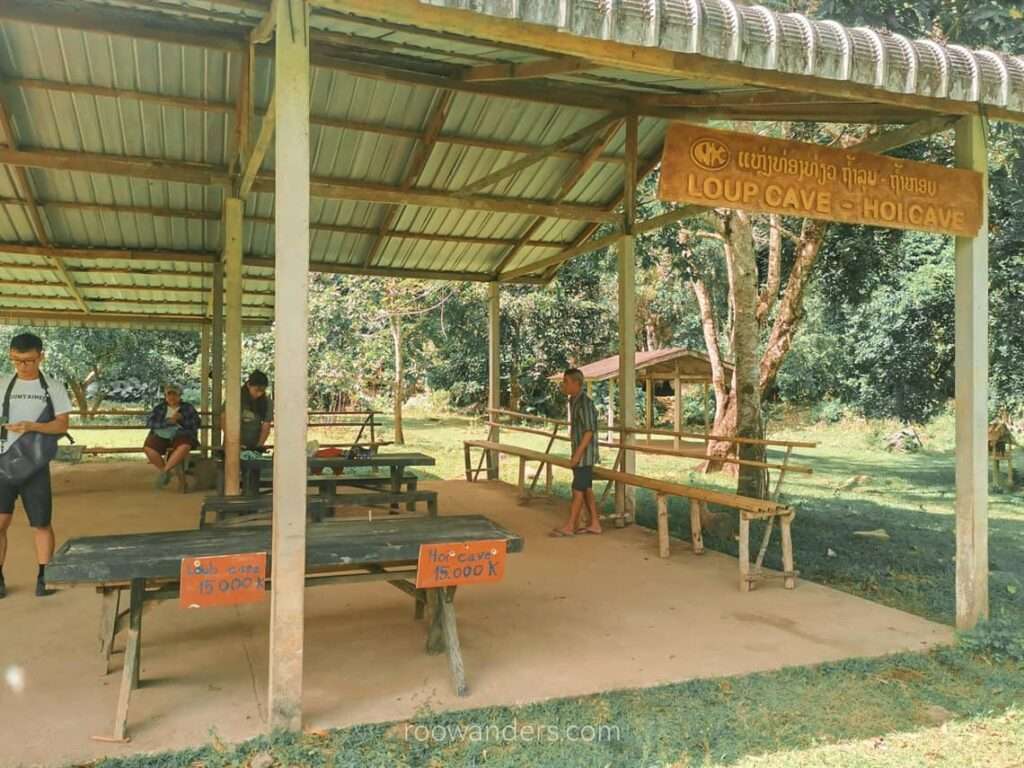
The first thing that greeted us within Tham Hoi was a massive Buddha. We edged past the Buddha and into the cave corridor, noticing smaller Buddhas hiding in the nooks or platforms of the walls within. There was graffiti left behind by other visitors. Otherwise, the cave was pretty secluded, and we were the only folks around that late morning.
There are beautiful cave dams – no cave pearls though! – and cascading stalactites.
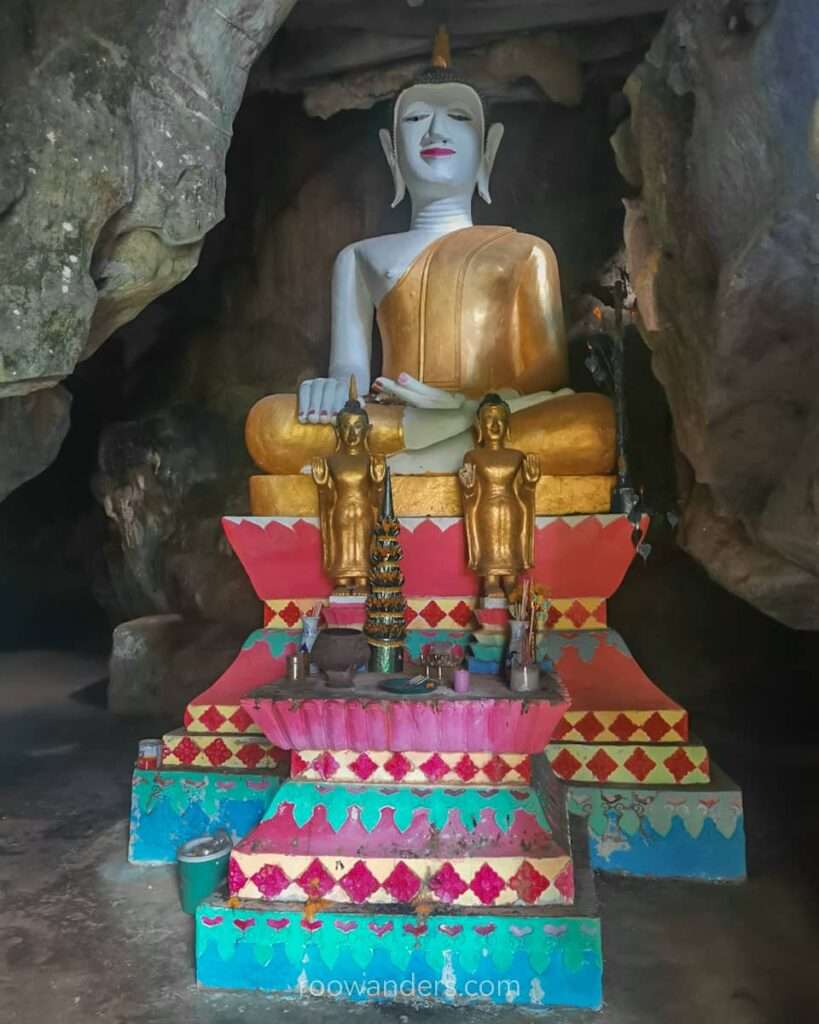
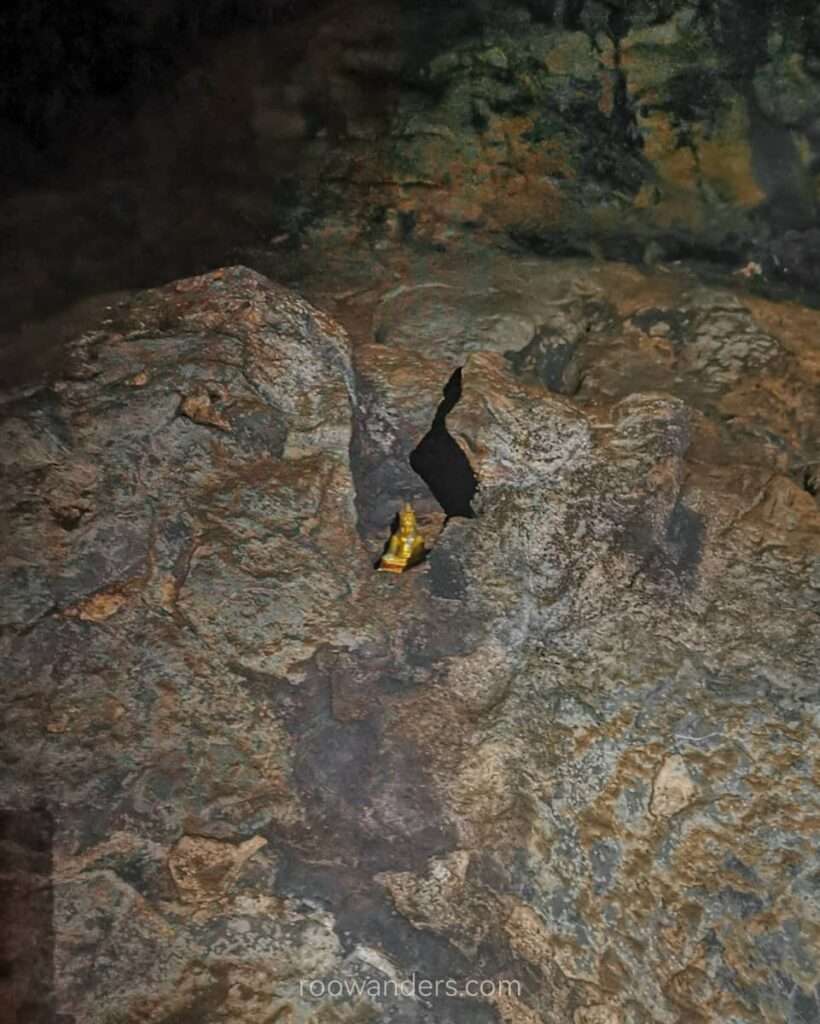
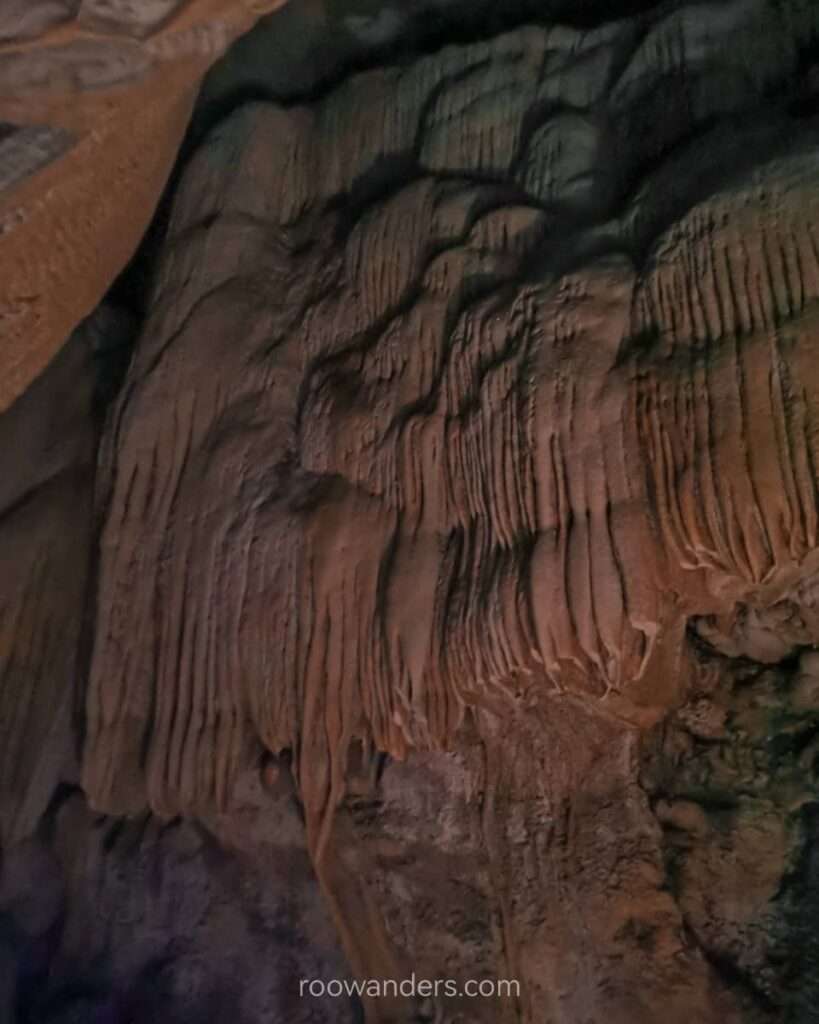
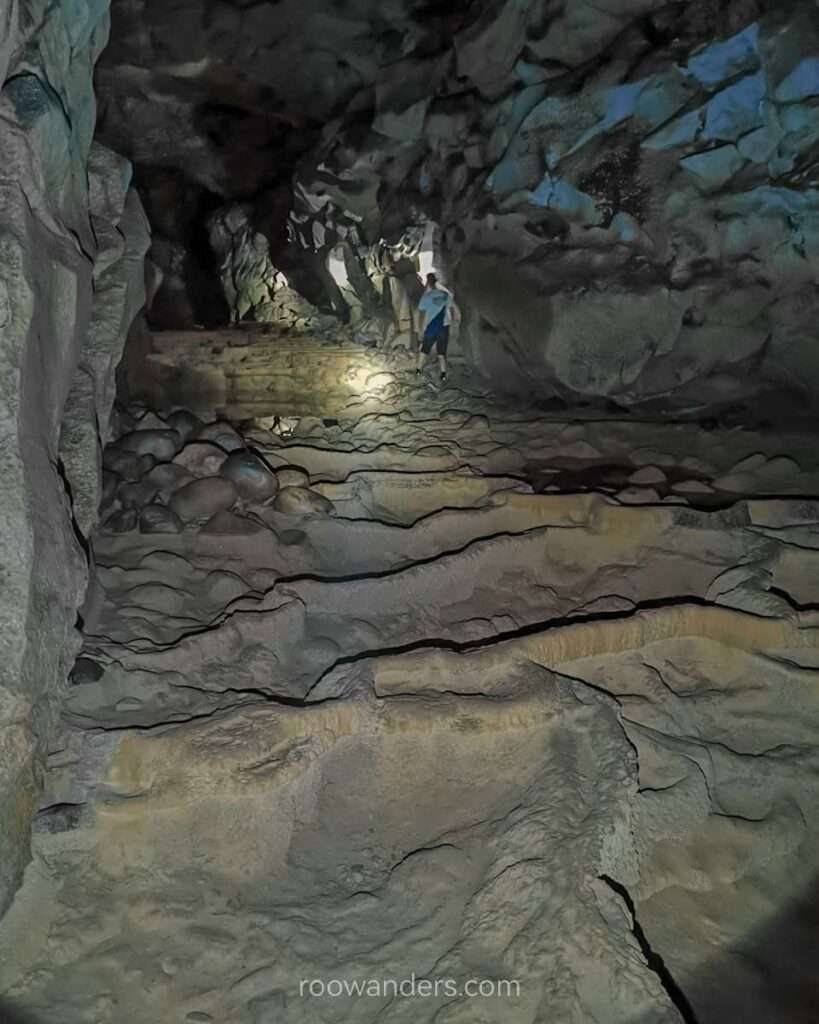
It was mentioned that an underground lake awaits after walking an hour. Some tours organise tubing into Tham Hoi from the other side of the mountain. If you’d like to visit the entire cave, do it with a guide from one of the tour agencies in Vang Vieng, as it is really secluded and undeveloped (read: dangerous).
Tham Hoi and Tham Loup (the next cave) used to be air raid shelters for the French and Americans in the 1940s and 1960s respectively.
Hole Cave (Tham Loup)
And finally, we have Tham Loup, otherwise known as the Hole Cave or Deep Cave. Entrance into this cave was a little unusual, as we had to climb down a flight of metal steps and rocks that could be slippery if wet.
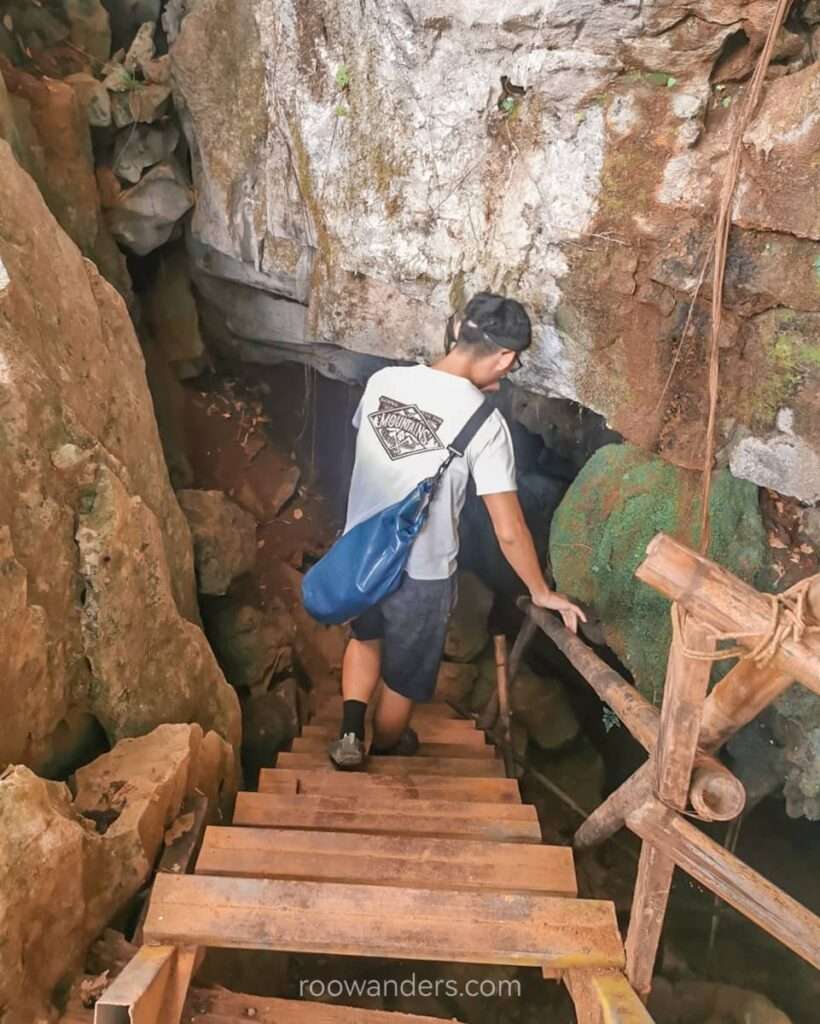
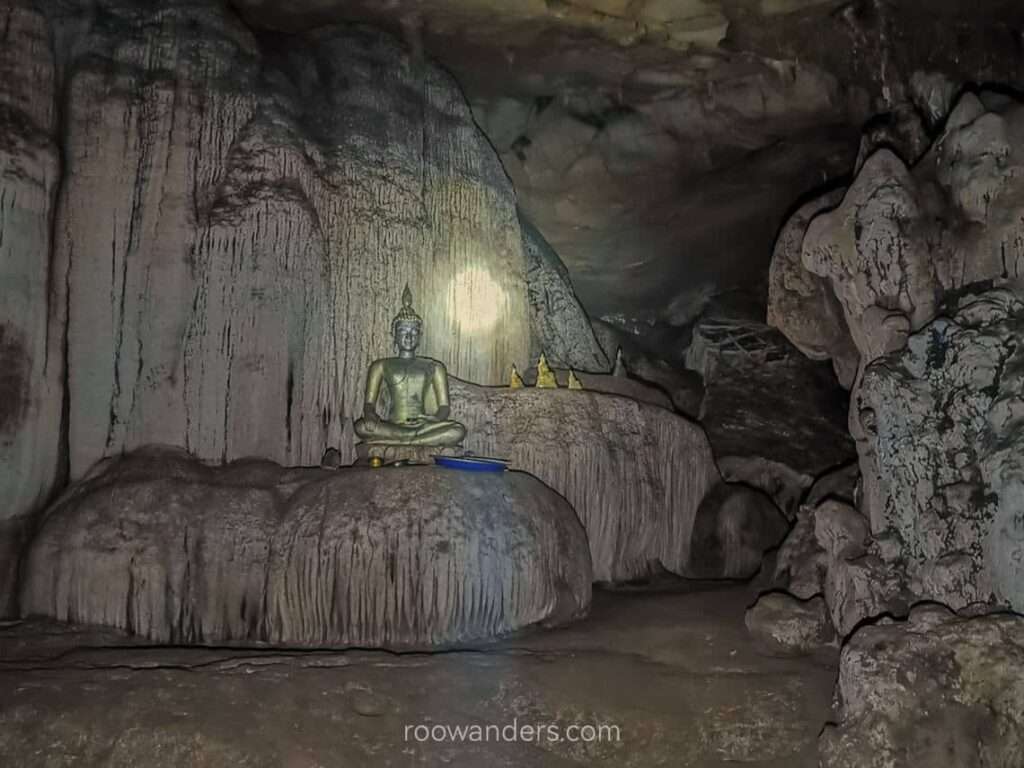
At the bottom of the steps is a huge cavern, with another bronze Buddha sitting before a cluster of cascading stalactites, lending the area an eerie vibe. We climbed over a rock hill to another huge chamber. There might be more to explore, but as the cave is undeveloped – there were deep drops on certain parts of the cave floor – and we’re no professional cavers, we exited via the same path.
See if you can spot the tiny white cave crickets and big hairy cave spiders!
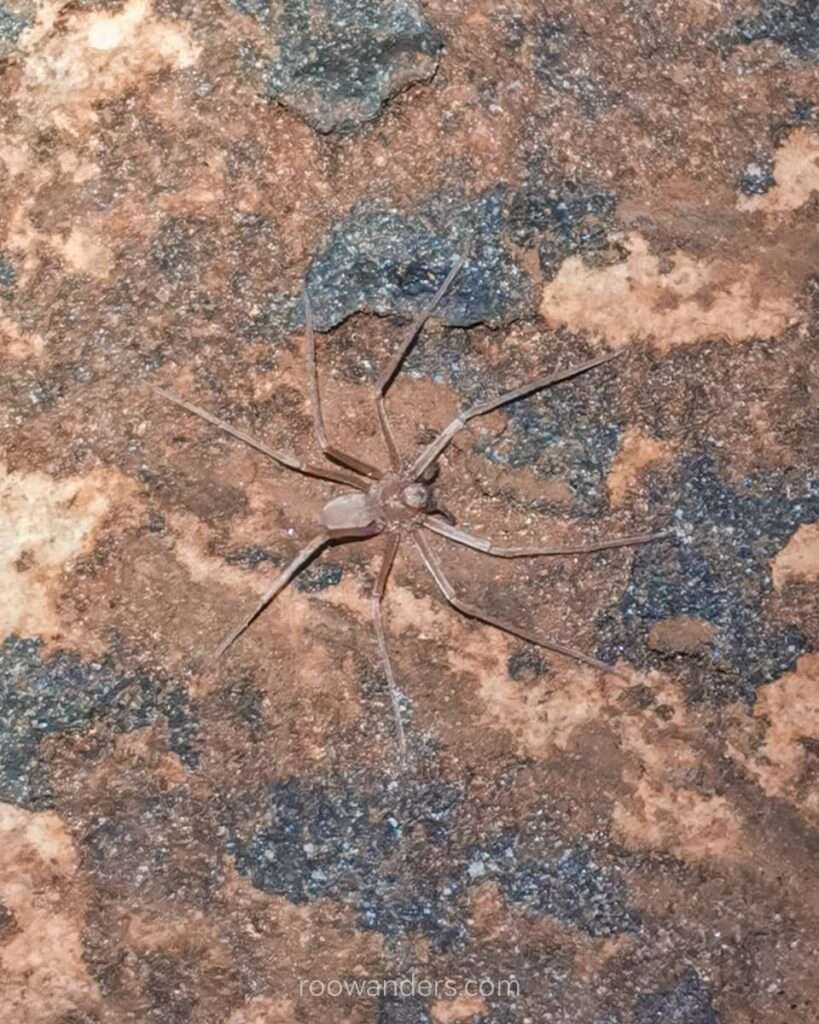
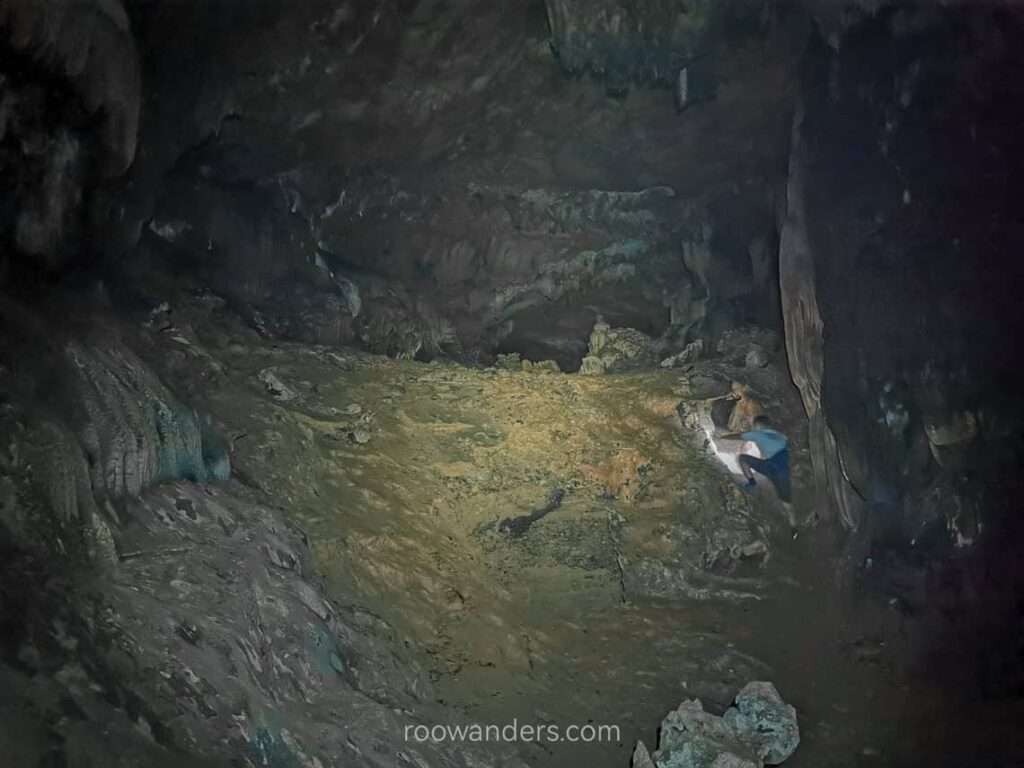
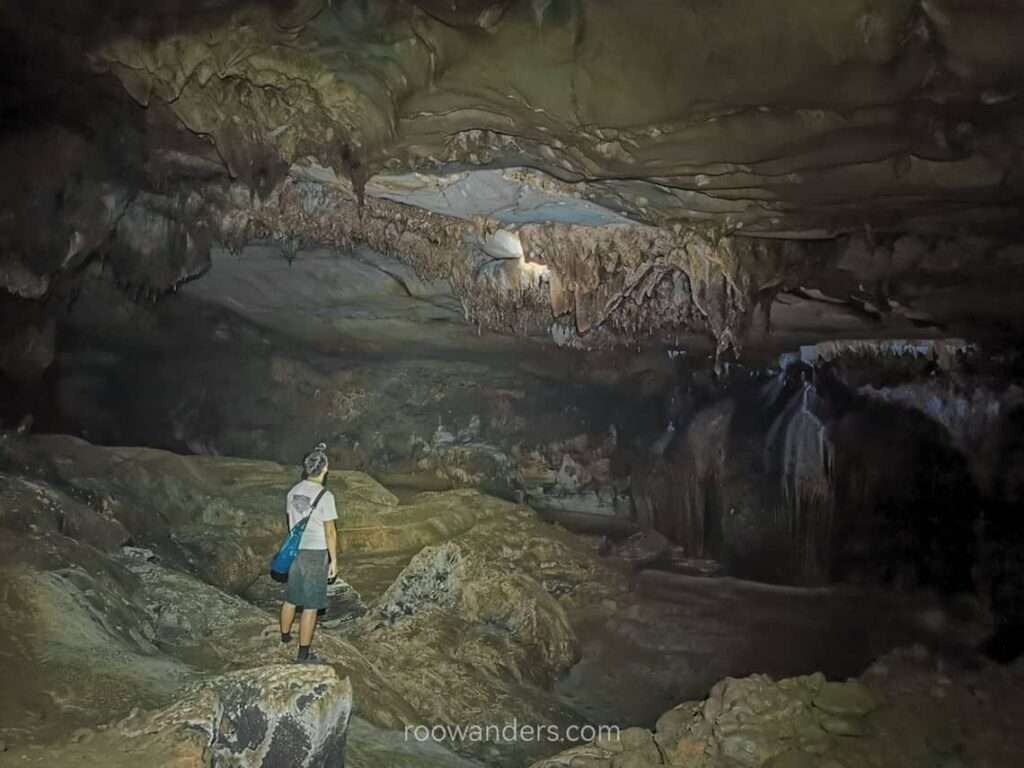
Others
Caves and karsts aside, Vang Vieng also offers activities up in the air, down the river, and over its muddy and bumpy wild roads.
Hot Air Balloon
Thinking of boarding the hot air balloon and enjoying the bird’s eye view? Know that you can do that in Vang Vieng at a very affordable rate – it might even be the cheapest in the world. But being cheap doesn’t equate to being less safe. I believe there is only one hot air balloon operator in Vang Vieng. Nevertheless, make sure you read the reviews before signing up.
Cost hovers around USD 135 per person for an hour-long flight, though this is highly dependent on the weather that day. There are two flights every day – early in the morning for sunrise, or just before sunset. Manage your expectations if you somehow did not catch the flight due to the weather!
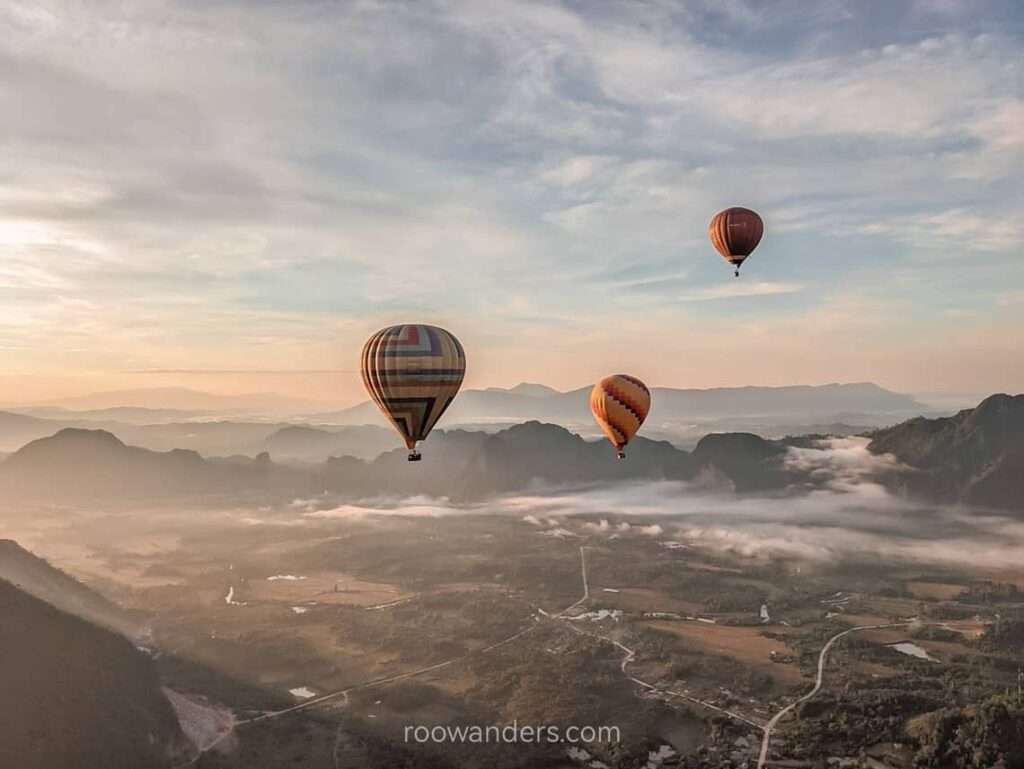
Paramotoring
Don’t want to share the basket with others? Well, you could do paramotoring with a pilot for around USD 100 per person.
As with the hot air balloon, you’d soar over and enjoy the sights of Vang Vieng countryside like a bird. Paramotoring is probably similar to paragliding, except the former comes with a motor at the back. I’m grateful to have experienced my share of paragliding in Nepal with eagles to boot.
Swim in the Lagoons
Vang Vieng has plenty of blue lagoons, and they’re really chalky bluish-green! Pretty much every cave in Vang Vieng has its own blue lagoon around its vicinity. There are a total of six blue lagoons listed on Google Maps, of which four are frequently visited by day-tours and travellers.
Lagoon 1 is the closest to Vang Vieng centre, within the same area as Tham Phu Kam, and where most visitors go.
Lagoon 4 is within the cluster of caves north of Vang Vieng.
Lagoon 2 and 3 are somewhat around the region of Lagoon 1.
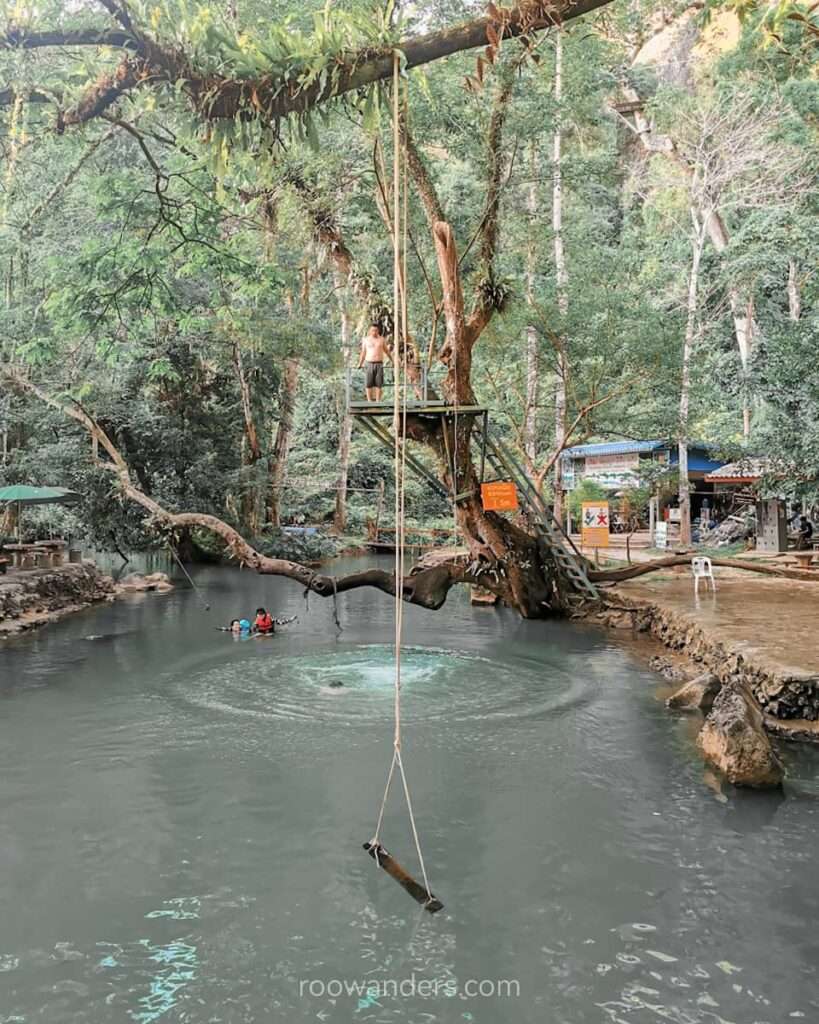
Kayak the Nam Song River
Most travel agencies in Vang Vieng have kayaking included in their full-day tours. Some have packages solely reserved for kayaking the Nam Song River – about 36 km – with lunch included! Enjoy the sights and sounds of rural Laotian countryside life as you meander down the tributary.
Tubing down the river
If you do not fancy exerting yourself, then why not sit in a tube and let the river bob you back to Vang Vieng. There are tubing packages every afternoon, at least from what I gathered from my hostel. You could book them from your accommodation on the day itself.
Buggy
Rent a buggy and whizz down the paddy field-lined potholed roads.
Zipline
As mentioned above, there are several places to zipline in Vang Vieng. Book a tour for a comprehensive package. Or DIY at Tham Nam.
Rock Climbing
When there are limestones, karsts and steep jagged rock walls, you’d find rock climbers. Because all these make the perfect haven for those who seek adrenaline on the walls.
I’m sure there are travel agencies there who could arrange everything on the spot. Or you could motorbike or hire a tuk-tuk yourself to get to the spot. Otherwise, here’s a tour that brings you to the rock wall with all the required gear and accessories.
Chase the waterfall
Visit the 30 m drop Kaeng Nyui Waterfall, northeast of Vang Vieng centre, and have a lovely time soaking by the pool. Note that the waterfall may be just a trickle during the dry season. It takes about 20 mins by motorbike to get there. Tickets should cost around 15 – 20k kip.
Places to eat in Vang Vieng
I stayed two days in Vang Vieng and had my breakfast taken care of at the hostel. For dinners, it has always been at the A.M.D Restaurant, a family-operated eatery, for their generous and delicious laap (50k kip).
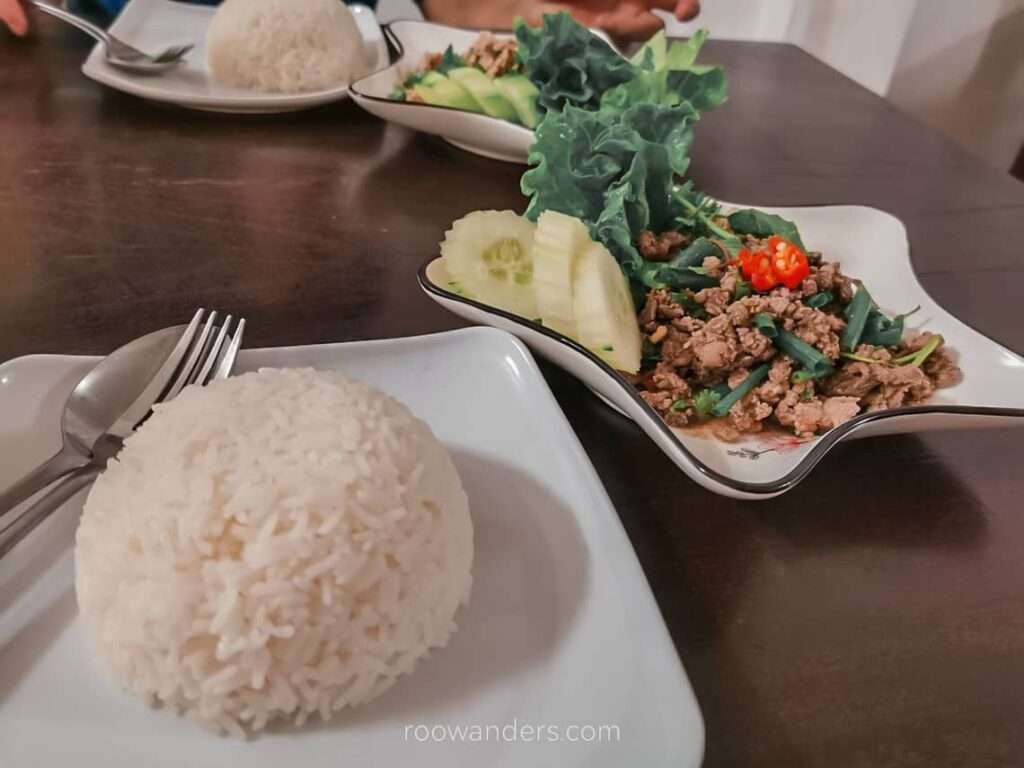
Several small noodle shops sell noodles and fruit smoothies. The food was ok, not the best, but it fulfilled its objective. You could get a bowl of pho for 30k kip.
My buddy and I had a delicious lunch at the Organic Farm and Restaurant as we travelled back from the cluster of caves towards Vang Vieng. Their iced mulberry and hibiscus juice (20k kip each) were terrific after a hot day out. I had chicken sate with vegetables (40k kip), one of the many choices in their thick booklet of a menu. The farm also sells mulberry wine and mojito, and star fruit wine.
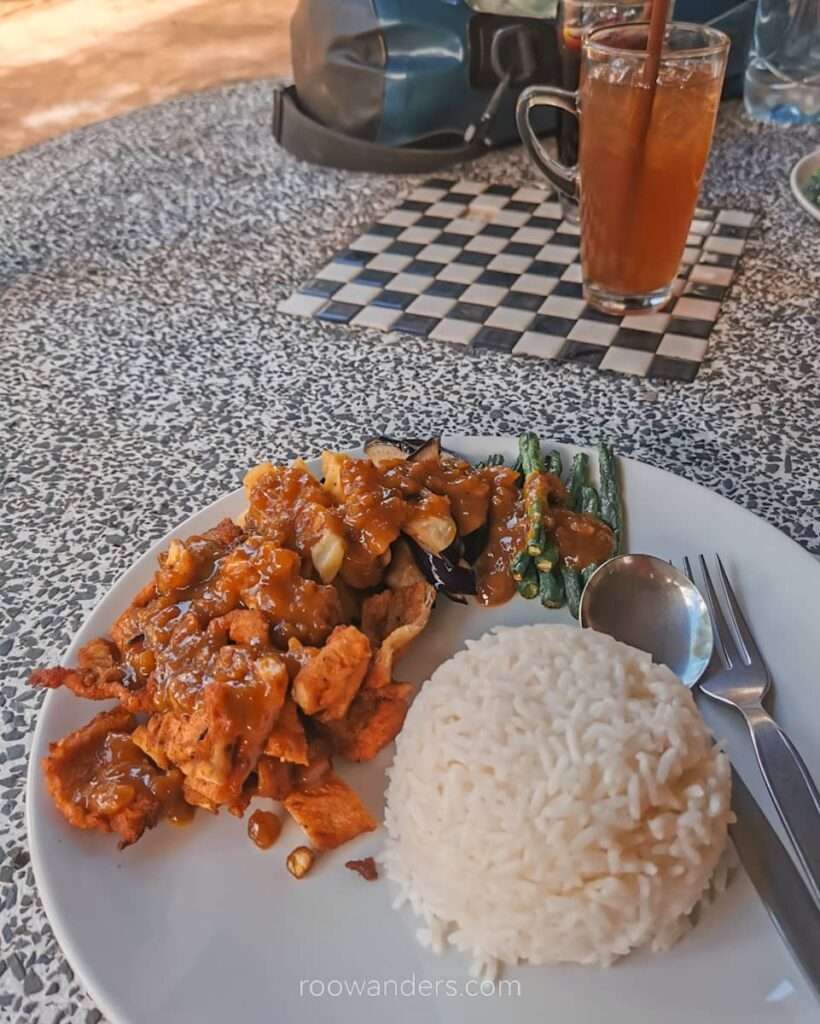
Accommodations in Vang Vieng
Budget Hostel. There are MANY hostels in Vang Vieng, and they’re all at very affordable prices, going as low as USD 5 for a night in the dorm. I stayed in the female dorm room of Vang Vieng Freedom Backpackers and found the staff hospitable. My room was generally clean, and the showers were just nice. My buddy stayed at Nana Backpackers Hostel, and from the looks of it, is a good place to consider. Otherwise, check out Vang Vieng Chill House for their very high reviews.
Mid-range. All hostels have private rooms. But if you’d like to stay somewhere quieter, check out the 3-star Premier Vang Vieng Hotel, Sansan Resort and Vang Vieng Diamond Resort. All three have beautiful pools and rooms and excellent reviews.
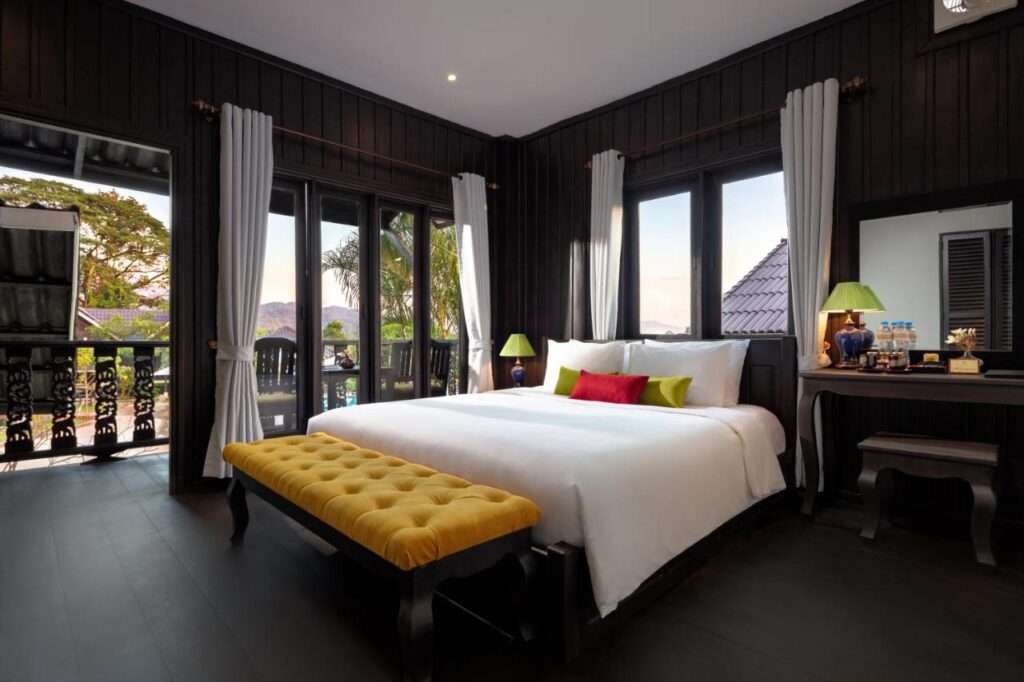
Luxury. There’s only one 5-star accommodation in Vang Vieng – the Tmark Resort. Those who have stayed have commented on the great hospitality and stunning views. Two other 4-star hotels with 9-pointer review scores include the Confetti Garden Hotel and the Riverside Boutique Resort. The latter is, as its name implies, by the Nam Song River overlooking the gorgeous mountains.
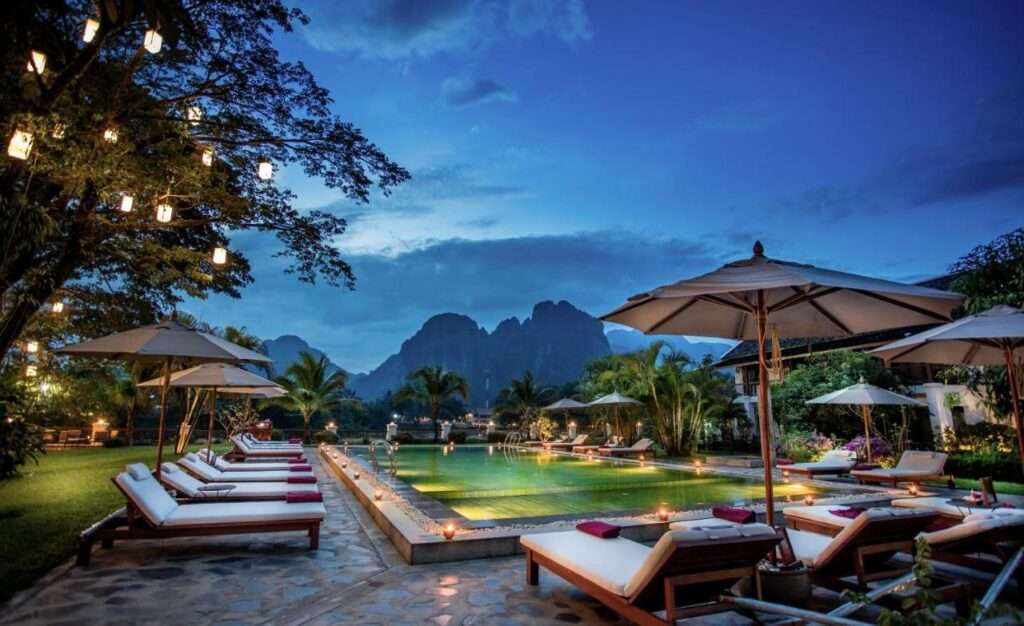
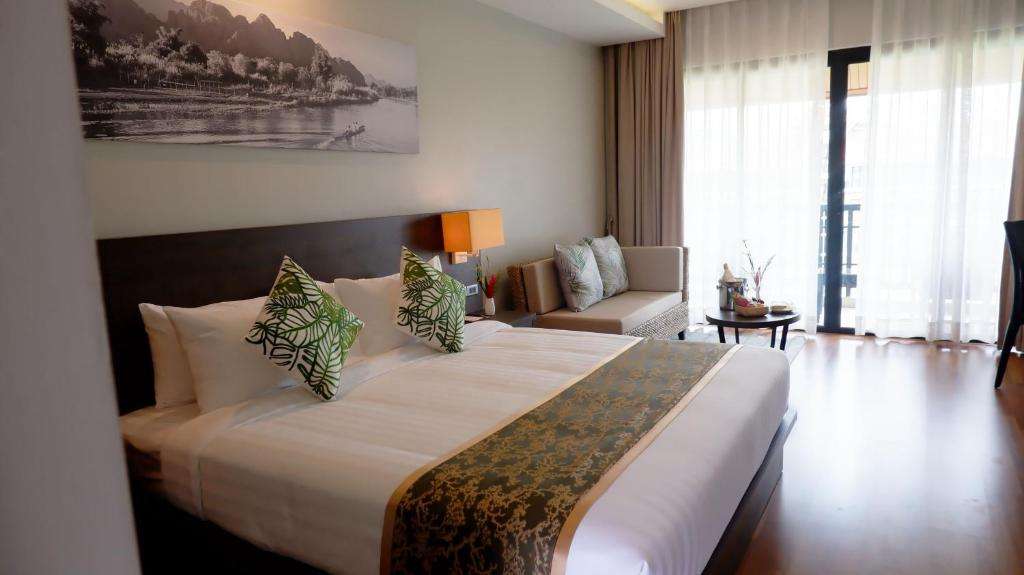
Travel beyond Vang Vieng
Vang Vieng is smack in the middle of a classic week-long itinerary in Laos between Vientiane and Luang Prabang.
Head north of Vang Vieng via bus or train to Luang Prabang for temples, waterfalls and cafes. From there, you could continue your journey north to more trekking adventures.
Head south to Vientiane, the capital, to take your flights out of the country, continue your journey into Vietnam or Thailand, or explore Southern Laos for its waterfalls and (more) caves.
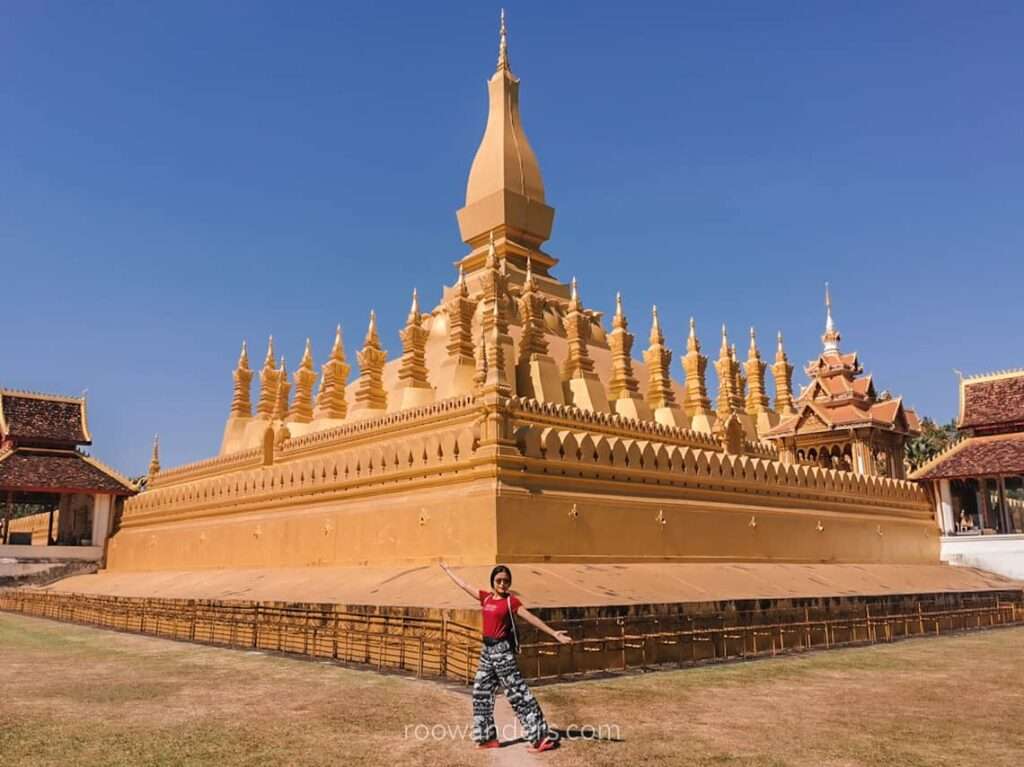
Conclusion/ Rambles
I’ve thoroughly enjoyed my stay in Vang Vieng – no less because of my travel buddy. The panoramic visage from Nam Xay and the remoteness of the caves Tham Loup and Tham Hoi were indeed enchanting. But what made the journey even more memorable were the rides to the destinations.
We rode over dubious wooden bridges, navigated the potholes and gravels of Vang Vieng’s notorious countryside roads, and enjoyed the changing scenery and setting sun as we went. Be it the motorbike, mountain bike or tuk tuk, the kayak, the hikes or the caves, you’d definitely enjoy the mix of adventure and tranquillity this little town has to offer.
